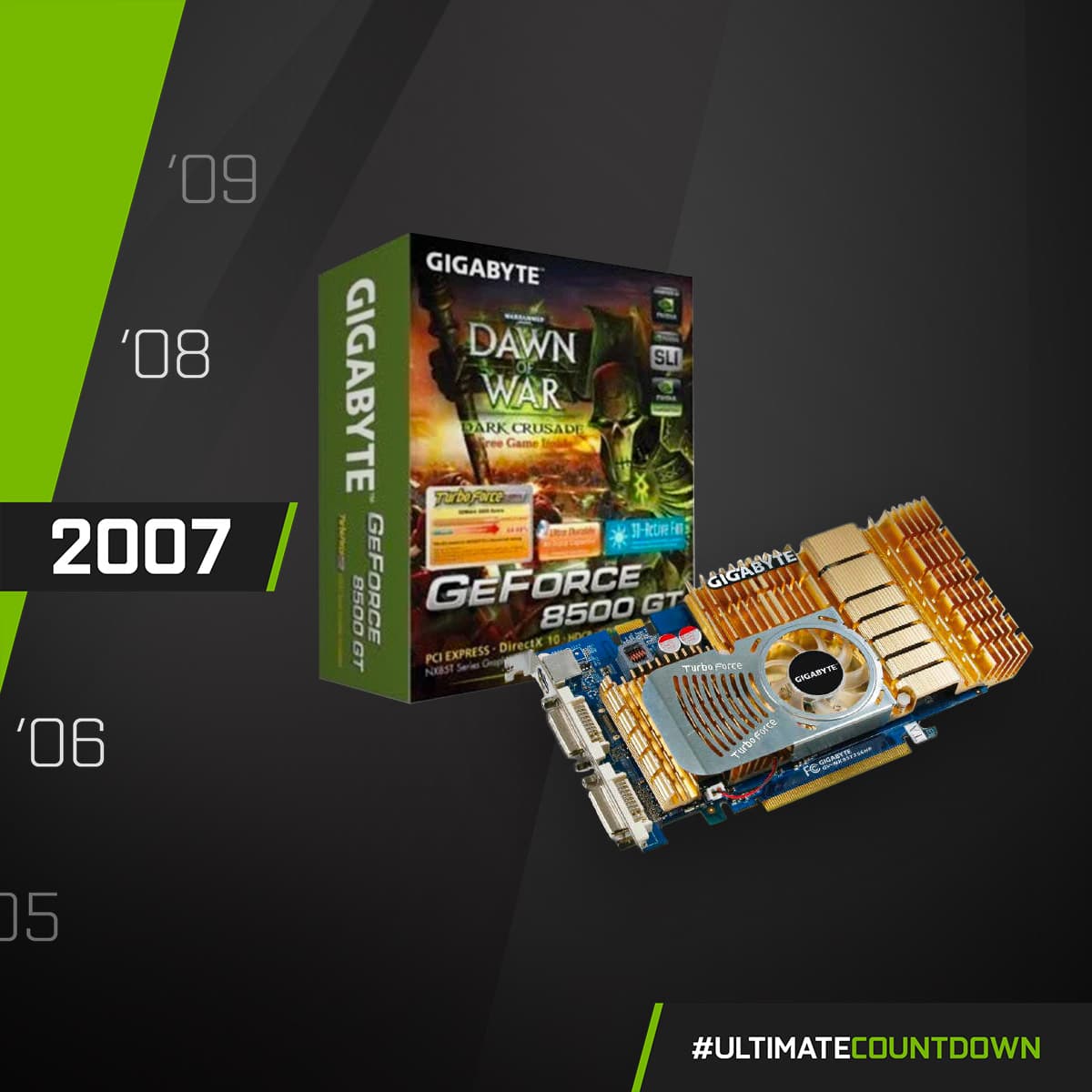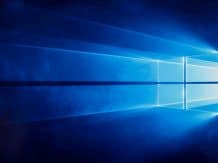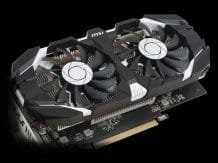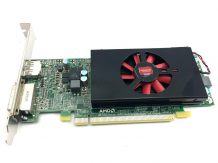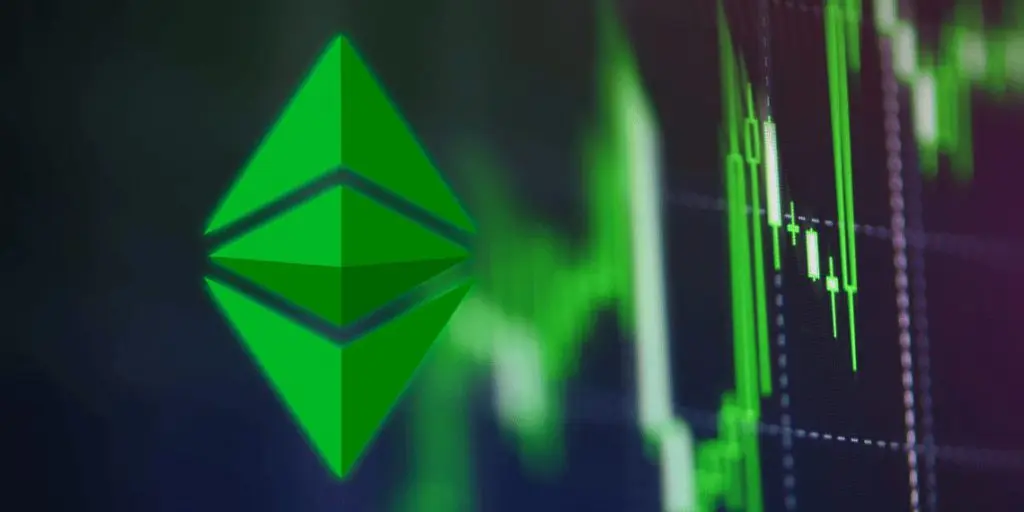NVIDIA GeForce 8500 GT Review: : (DVI-I, Dual Link) | Power Supply (WATT)| Accelerator – Budget video cards for DirectX 10 from NVidia are gradually filling the market. But as we could see in the recent testing of the GeForce 8600GT , the price of such cards doesn’t match their performance yet.
Next in line is the youngest model of the 8th series – GeForce 8500 GT. In this test, the video card GeForce 8500GT from XpertVision will be considered in comparison with competitors. We have not forgotten about overclocking.
Acquaintance with this card began with a small curiosity. The fact is that the XpertVision GeForce 8500GT adapter was packed in a small box from GeForce 8600GT already familiar to us from the last article, as the label on the front side of the package proudly stated. Only a sticker on the side part spoke about the true contents.
The budget representative of the eighth series of the last generation of video cards is unlikely to appeal to fans of resource-intensive dynamic games. However, it is the NVIDIA GeForce 8500 GT adapter that is destined to occupy the initial niche of discrete devices that can compete with integrated solutions on the computer components market. In this article, the reader will take a closer look at an interesting and inexpensive graphics accelerator, find out its potential and technical characteristics. Owner reviews will help you see all the disadvantages and advantages that the manufacturer is silent about.
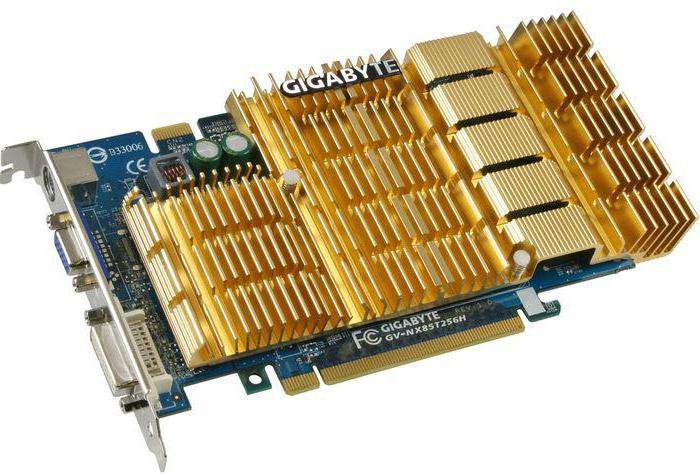
Chip features
The G86 budget graphics processor, based on 80 nm technology, has a fairly low power consumption – only 30 watts at maximum load. Therefore, users have a lot of questions about the overclocking potential of the NVIDIA GeForce 8500 GT video card. The technical characteristics that determine performance are quite acceptable for working with non-resource-intensive dynamic games and applications:
- the graphics core operates at a frequency of 450 MHz;
- effective shader frequency is 900 MHz;
- GDDR3 memory uses a 128-bit bus and supports 800 MHz;
Confuses only the amount of RAM installed on the graphics accelerator – only 512 MB. Sometimes on the market you can find video cards equipped with 256 megabytes of RAM, which, in general, bewilders many users. For operation, the video adapter uses the PCIex16 bus, however, the first revision.
Main competitor
Any product present on the computer market is an improved analogue of competitors’ products. Naturally, NVIDIA is fighting for the championship with the AMD brand. The video card NVIDIA GeForce 8500 GT, whose characteristics are more aimed at the budget segment, has a very interesting opponent on the market – ATI Radeon X1650 Pro. Two video adapters are almost identical both in appearance and in technical characteristics, which is why there is a lot of controversy about plagiarism.
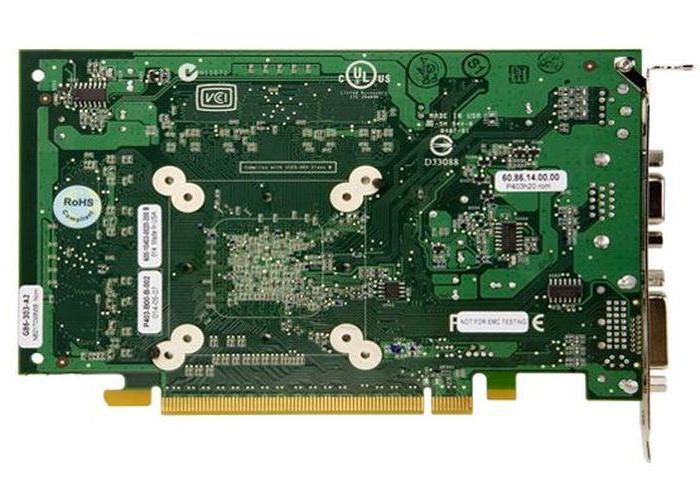
Both graphics accelerators are not demanding on power, their performance is at the same level, however, many users managed to find one significant difference. It is connected with the built-in video capture controller (VIVO) from the AMD brand. It is rather strange that the manufacturer NVIDIA did not install a similar board, because many designers, editors and creative people look after video cards in the budget class.
Demanded accelerator
In whatever class the video adapter is present, it will always find a buyer, but, in addition to performance, many users are interested in another feature of the device – quiet operation. After all, everyone wants to work and relax in silence, and not listen to the howling of the cooling system fan at high speeds. It is this demanded quality that draws attention to the NVIDIA GeForce 8500 GT video card, the technical characteristics of which do not allow the graphics core to overheat.
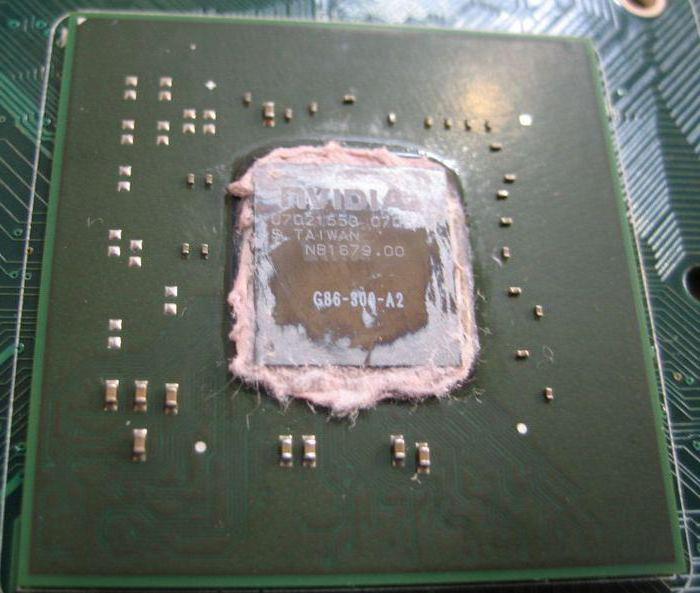
The manufacturer placed all the batteries in a separate block on the interface panel, leaving a flat area with a processor and memory. Naturally, many video adapter manufacturers took advantage of this by installing a copper or aluminum radiator instead of an active cooling system.
How to download and install new drivers
On Windows 10, you don’t need to do anything, because the operating system itself will find and install the most up-to-date versions of drivers for components and peripherals when you first connect to the Internet.
Some problems may arise on Windows 7, since it is not always able to find the right version of the software.
To download the driver for Nvidia Geforce 8500 GT, you need the following:
- Go to the official Nvidia website and select the drivers section.
- Specify the video card model and operating system, then click on the “Search” button.
- Download the file that appears.
- Install the program on the computer.
After such actions, the latest version of the driver will be used on the PC.
The second option is to use these drivers:
For Windows 7, 8.1, 8 and Vista
For Windows 10
File size:
290.00 MB Driver version: 342.01 (WHQL) from 12/14/2016; Language: Russian Operating system: Windows 10 32/64-bit, Windows 7 32/64-bit, Windows 8.1 32/64-bit, Windows 8 32/64-bit, Windows Vista
In the factory
The budget representative has small physical dimensions (160x100x15 mm), allowing it to be placed in any system unit, including micro-ATX and Barabone. To install a video card, you need only one slot, which is quite convenient when assembling multimedia computers that will use PCI expansion cards. The only thing that confuses me is the poor interface panel in the NVIDIA GeForce 8500 GT video adapter. The characteristic of many users is no longer satisfied, because the VGA, DVI and TV-out connectors are obsolete, and HDMI could improve the situation.
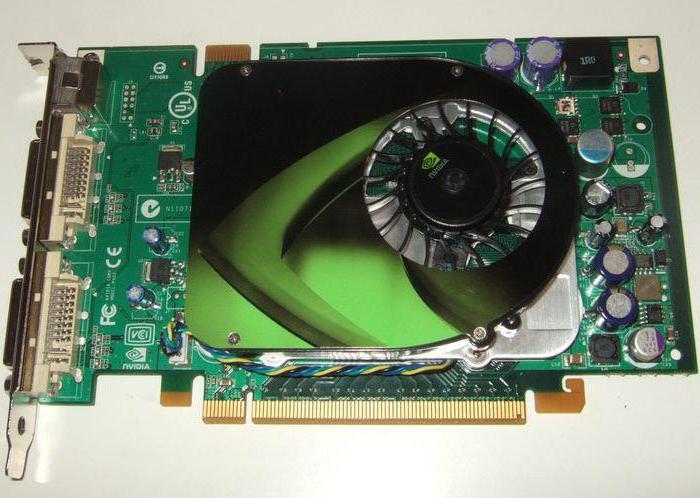
There are no questions about the batteries on the printed circuit board: the manufacturer installed ordinary electrolytic capacitors that practically do not heat up. There is no need to talk about phases and power distribution either, since the graphics accelerator has a complete order with power supply. We can only note the strange placement of the contact for connecting the cooling fan. It is located near the PCIex16 contacts and rests against the motherboard slot when installing a video card.
Video cards for $100 and below: tests of the GeForce 8500 GT and three other video cards in the lower price range
- The blue PCB textolite of the video card is less saturated with elements in comparison with PowerColor. All memory chips are also located only on the front side:
At the top of the board there is an MIO interface for combining two such video cards in SLI mode. In addition, the video card is equipped with analog, digital (DVI-I) and TV outputs:
The cooling system of the video card is attached with two plastic clips, removing which you can see a very small graphics processor:
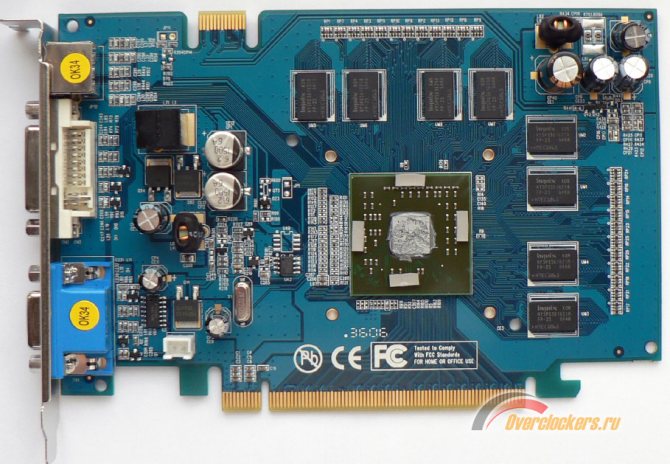
As a thermal interface, BFG uses some kind of thick gray thermal paste, which is almost dry. In order to prevent chipping of the chip, small rubber compensators are glued along the edges of its substrate to avoid distortion of the heatsink during its installation and removal:
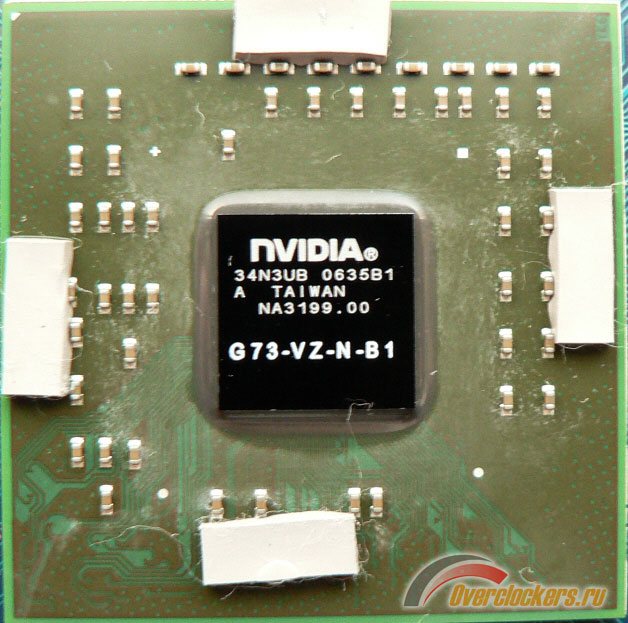
The G73 GPU, revision B1, was released in Taiwan on week 36, 2006. Its area is only 127 sq.mm. The GPU operating frequency is slightly increased relative to the nominal value – by 25 MHz and is 375 MHz against 350 MHz according to the GeForce 7300 GT specifications. Nevertheless, such an insignificant increase in the frequency of the chip allows BFG to add the letters “OC” to the name of the video card, denoting the overclocked version of the card. You could already see other characteristics of the chip in the table earlier.
Eight GDDR-2 memory chips released by Hynix:
Judging by the marking – HY5PS561621A FP-25 – their nominal access time is 2.5 ns, which corresponds to an effective theoretical frequency of 800 MHz, while the memory operates at 667 MHz. There is no increase from the GeForce 7300 GT specifications here. The width of the video card memory exchange bus is 128 bits.
The lightweight aluminum heatsink of the cooler is cooled by a small fan with transparent blades. A two-pin power wire indicates in advance that there are no means of monitoring the fan speed:
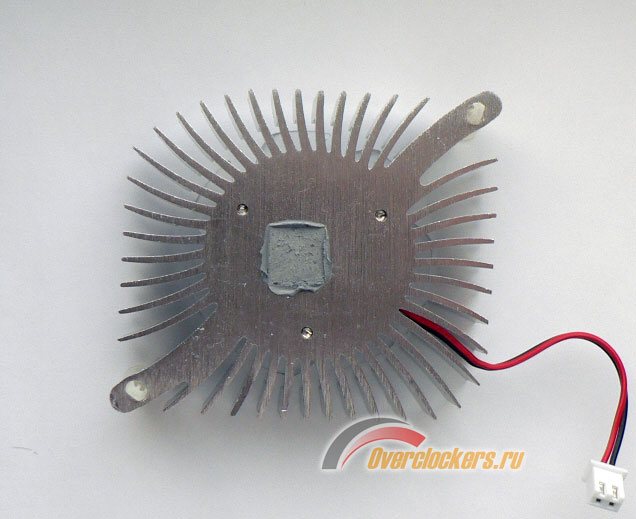
Judging by the noise from it (3 cm – 58.1 dBA, 1 m – 38.4 dBA), the fan rotates at a constant speed.
Before proceeding to the study of the overclocking potential of the video card, its temperature regime was checked. Here and below, such a check was carried out using a ten-fold run of the Firefly Forest benchmark from the 3DMark 2006 synthetic graphics benchmark without activating any quality improvement techniques. Temperature indicators were monitored using RivaTuner v2.01. Room temperature during testing was 24 degrees Celsius. In all cases, Fanner 420 thermal paste was used as a thermal interface. As a result, the graphics chip warmed up to 60 degrees Celsius:
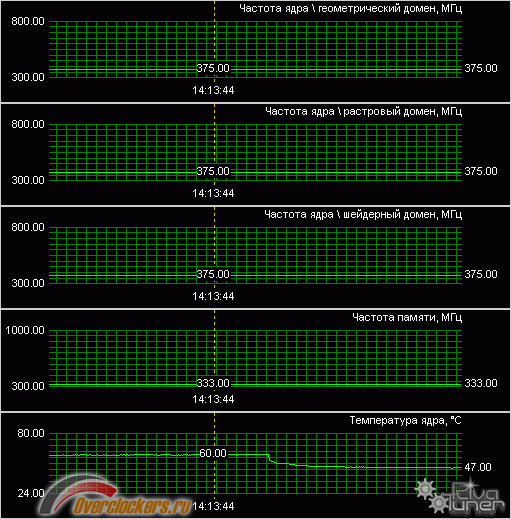
Very modest by today’s standards, but even more modest was its temperature after installing the Arctic Cooling Accelero S2 video card with a fan, namely, it dropped to 41 degrees at peak load, and in the passive mode of the radiator did not exceed 53 degrees. However, such a noticeable decrease in temperature did not allow increasing the overclocking potential of the card in relation to the standard BFG GeForce 7300 GT OC cooler. The maximum frequencies were 486 MHz for the GPU and 907 MHz for the video card memory:
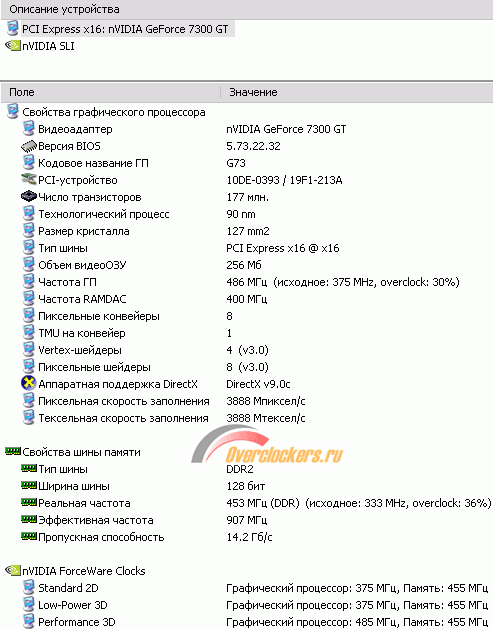
Even despite overclocking, the pixel and texel fill rates of the scene, and the memory bandwidth of the GeForce 7300 GT remain depressingly low. What to do, low end is low end…
You can download the BIOS of the video card BFG GeForce 7300 GT OC 256 MB from our file archive (WinRAR, 41.9 KB), and it is offered at a retail price of 81 US dollars.
- Zotac GeForce 7600 GS 256 Mb
A new company on the Russian market – ZOTAC – is a subdivision of PC Partner (like Sapphire Technology) and entered the market, massively presenting the entire line of video cards based on new NVIDIA chips, starting with GeForce 8500 GT and up to 8800 Ultra. However, Zotac’s product range also includes products based on NVIDIA’s previous generation chips. Today’s test participant is just one of them. Meet Zotac GeForce 7600 GS 256 MB:
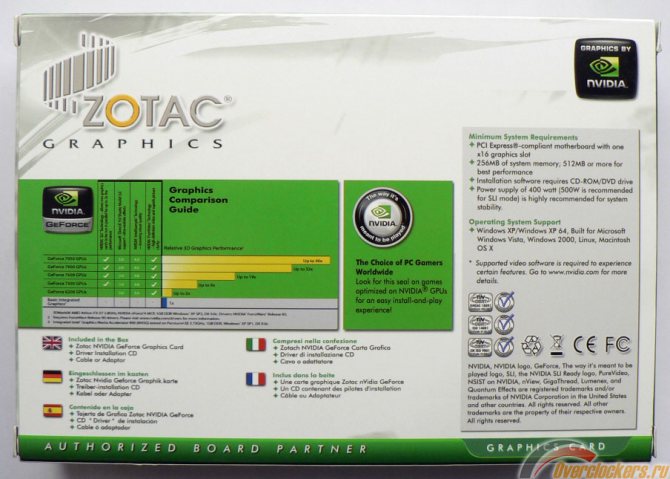
On the front side of a very small box, a robot with blue eyes and an incomprehensible facial expression is depicted. In addition to the name of the video card and the amount of memory, you will not find anything interesting next to this robot, but on the reverse side, in addition to describing the technical characteristics, there is a small diagram with the performance of GeForce 7xxx video cards.
The delivery set of the video card is poor to the point of impossibility:
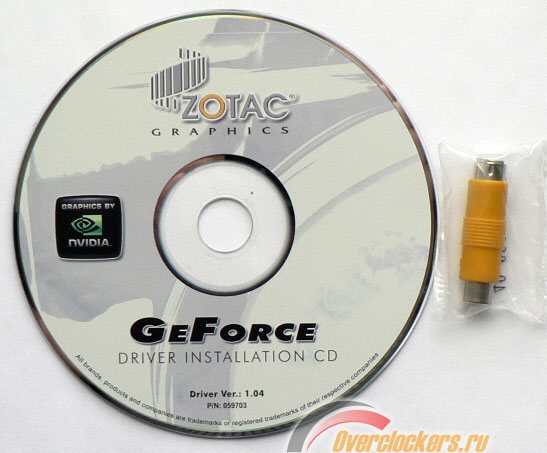
Only a CD and a small adapter are included in the box. Sometimes, even in the OEM configuration, many manufacturers (for example, Sapphire) have much more useful things than the Zotac GeForce 7600 GS.
The video card is literally shorty, see for yourself:
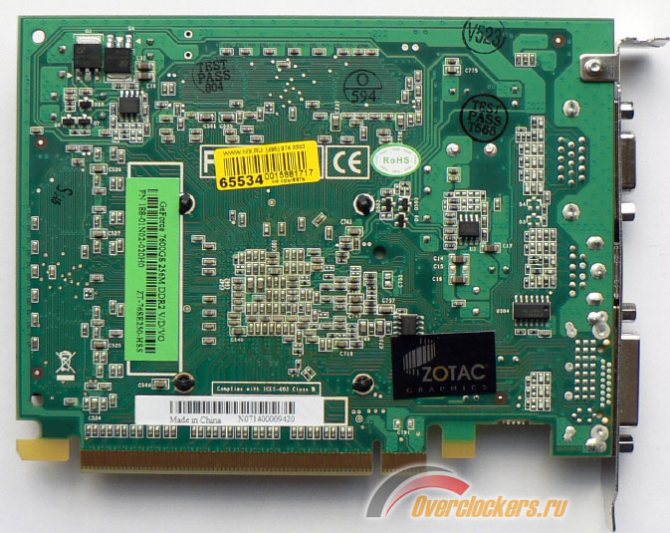
Its length ends flush with the motherboard PCI slot latch. Even before the review of the GeForce 8500 GT in the next subsection, I confidently award this video card the first (and only) prize “for compactness”
A passive aluminum heatsink that contacts only the graphics chip – that’s the whole video card cooling system, well, maybe it’s better? We will check a little later, but now I will add that the video card is equipped with video, analog and digital outputs:
Unfortunately, there is no MIO connector, so you can safely forget about organizing the operation of two such video cards in SLI mode.
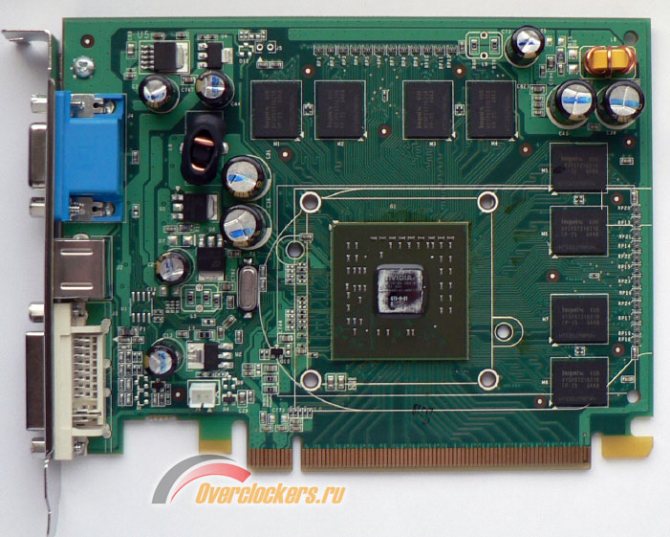
Eight video card memory chips are located only on the front side of the PCB. The GPU is also located there, G73 revision B1:
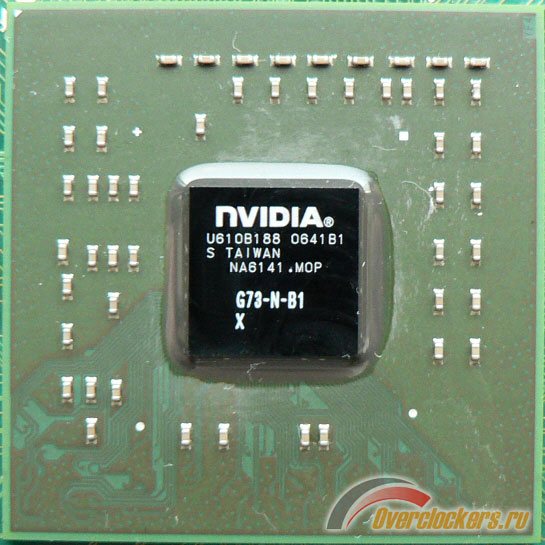
The chip operates at a frequency of 400 MHz, which corresponds to the GeForce 7600 GS specifications. Release date: 41 weeks last year.
Complies with the specifications and the effective frequency of the memory of the video card, which is 800 MHz. Zotac GeForce 7600 GS has 8 GDDR-2 memory chips manufactured by Hynix:
Their marking: HY5PS121621B FP-25, which indicates a nominal access time of 2.5 ns and a theoretical frequency of 800 MHz.
The passive heatsink of the cooling system contacts the graphics chip through a thermal pad:
In addition, under this green sticker for something there is a silver-colored thermal paste. There is no doubt that such a multilayer contact will not contribute to the organization of efficient heat transfer, which was immediately confirmed by tests:
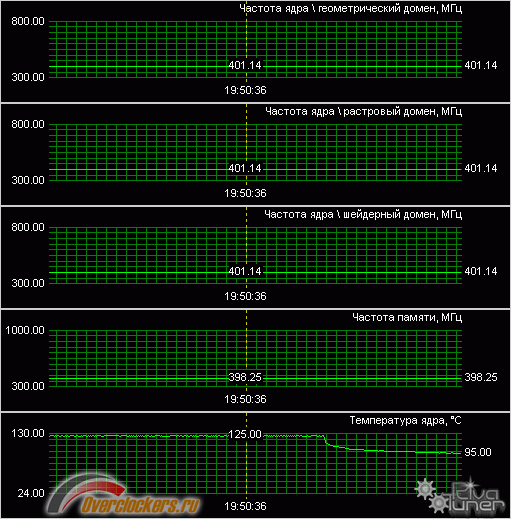
125 degrees at the peak of the load on the chip for a video card with such a modest level of heat dissipation is an unacceptable temperature. A simple replacement of the thermal sticky tape and a layer of “silver” thermal paste with the Fanner 420 thermal interface with the same passive heatsink led to a decrease in temperature by 35 degrees Celsius! However, even at 90 degrees on the chip, there was no question of overclocking, so the passive radiator was replaced with a Zalman VF900-Cu LED (Arctic Cooling Accelero S2 does not fit this video card). The temperature immediately returned to normal:
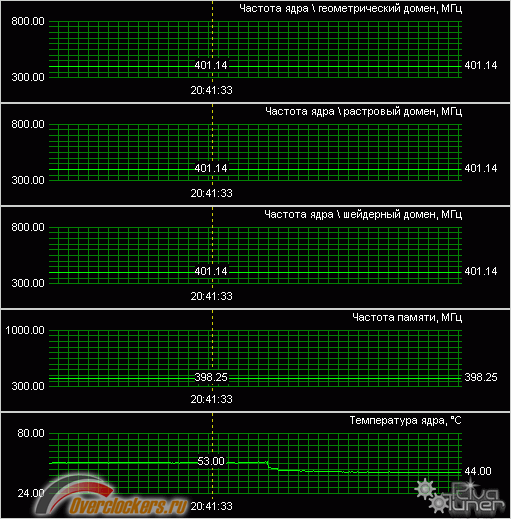
After that, it was found that the maximum frequencies at which the Zotac GeForce 7600 GS remains stable are 540 MHz for the GPU and 954 MHz for the video card memory:
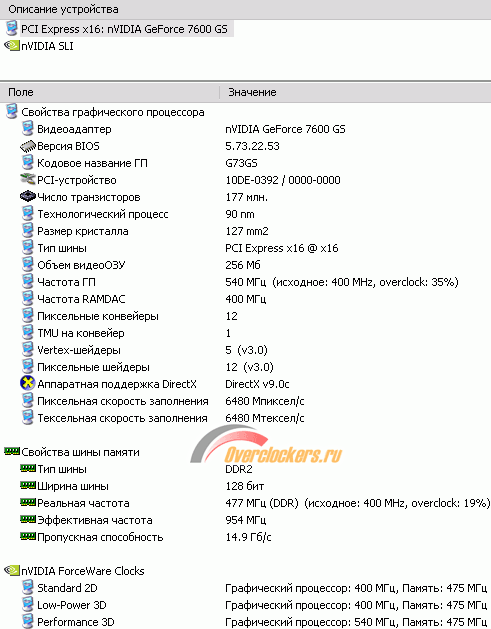
I will add that at the same time the temperature regime of the video card has not changed.
You can download the BIOS of the video card Zotac GeForce 7600 GS 256 MB from our file archive (WinRAR, 41.6 KB), and it can be purchased at retail for $84.
- Palit GeForce 8500 GT Sonic 256 Мб
The video card produced by Palit comes in a package that is already well known to us, mostly yellow:
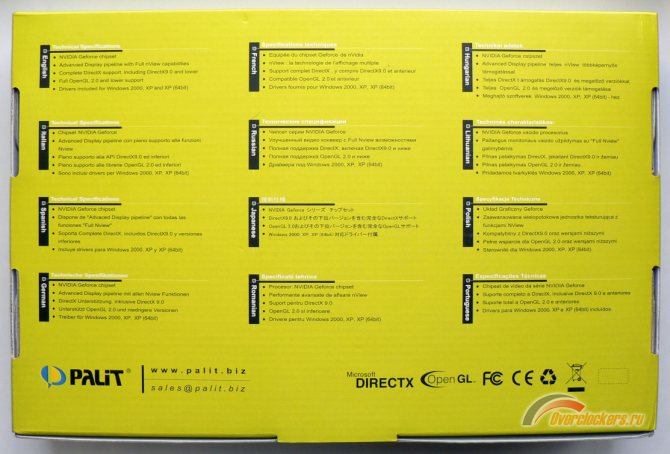
Next to the frog on a small sticker on the front of the box are the frequencies of the video card, the amount and type of memory, the bit width of the bus for the exchange with the memory of the video card, as well as other less useful characteristics of the device.
The video card is located in the most secure central compartment of the box, while the rest contain the following accessories:
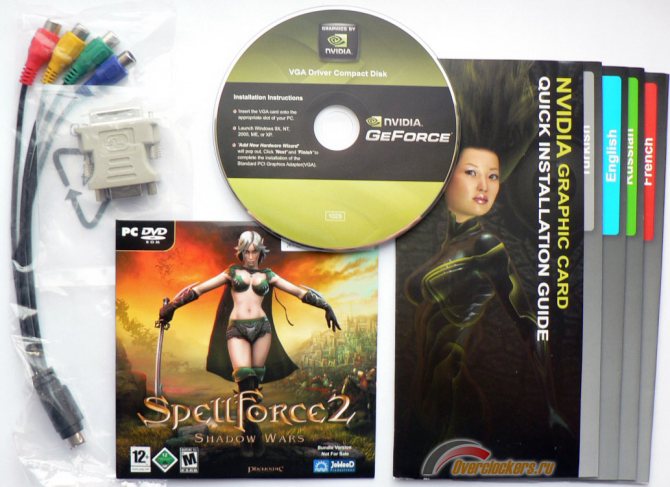
- splitter adapter;
- one 15 pin DVI / D-Sub adapter;
- CD with drivers;
- Spell Force 2 CD;
- a brochure on installing the card and drivers in several languages (including Russian).
The video card is based on a green PCB, and most of the textolite is empty:
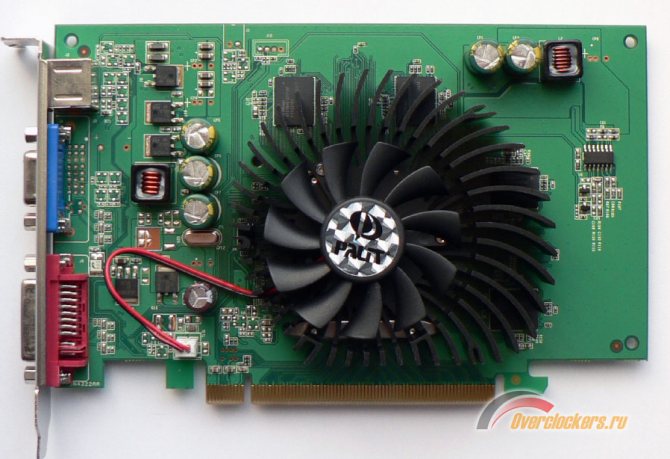
The cooler’s aluminum radiator has a rather original shape – the blades on one of its sides are elongated, thus increasing the heat exchange area. This radiator is cooled by a 70mm fan with a holographic sticker on the spindle.
The cooling system is fastened through the board with two clamping clips with plastic and soft substrates:
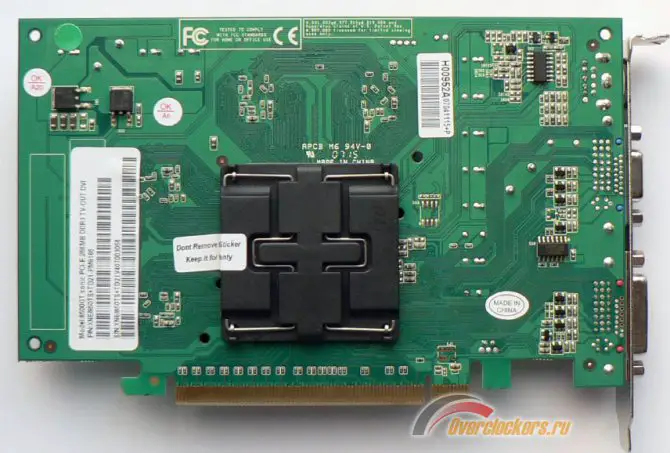
Simple and reliable fastening, the risk of chipping the chip is minimal here.
The video card is equipped with analog, digital (DVI-I, Dual Link) and TV outputs:
Without a cooling system, the board looks like this:
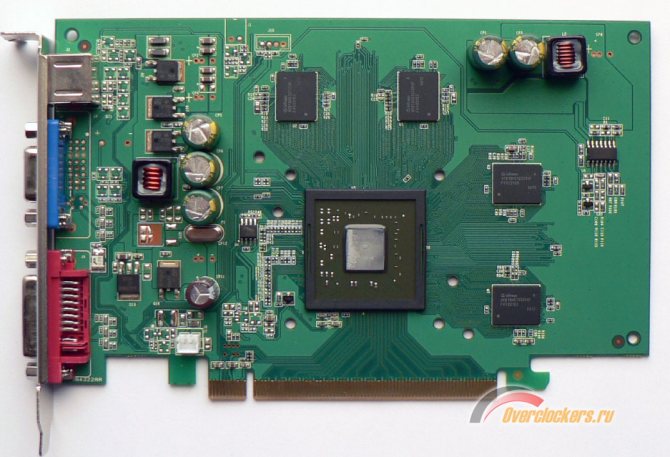
Again, I note the empty PCB textolite, the lack of a connector for connecting additional power to the video card and the MIO interface. Most likely, with such a simple PCB, there are still reserves to reduce the cost of an already cheap video card.
The graphics processor is carefully bordered by a plastic frame that protects the chip from chipping:
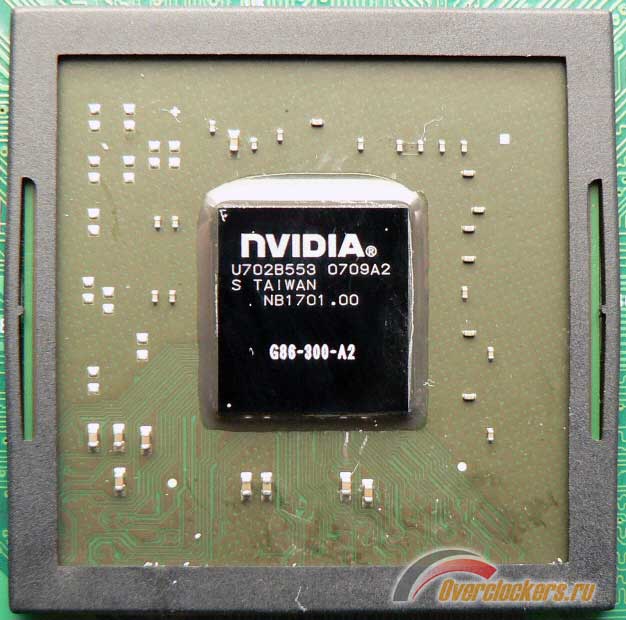
GPU revision – A2, release date – week 9, 2007. The frequency of the graphics processor is 600 MHz, which is immediately 150 higher than the specifications of the GeForce 8500 GT.
MHz. The shader unit of the GPU operates at a frequency of 1200 MHz.
The entire 256 MB memory capacity of the video card is filled with four GDDR-3 chips manufactured by Infineon:
There are no descriptions of chips marked HYB18H512329AF on the official site, but according to the information that I managed to find in our conference, their nominal access time is 1.4 ns. The memory frequency is also increased relative to the nominal GeForce 8500 GT, only now it is immediately by 400 MHz with a total of 1200
MHz. Perhaps, in the performance of Palit GeForce 8500 GT Sonic 256 MB, we can observe one of the highest (if not the highest) factory overclocking:
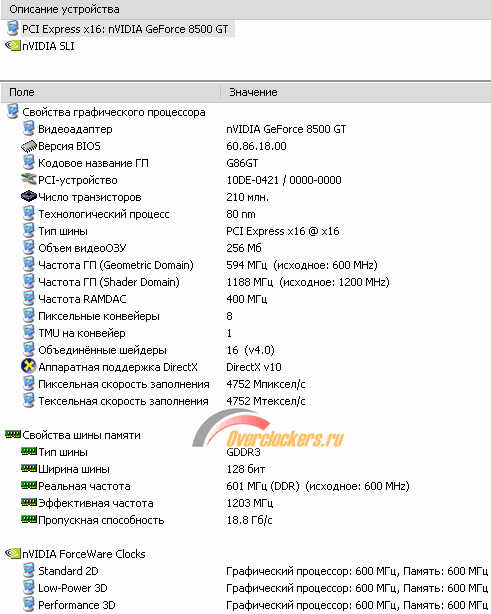
As a thermal interface between the GPU and the base of the heatsink, a thermal sticky tape is used, which has completely dried up:
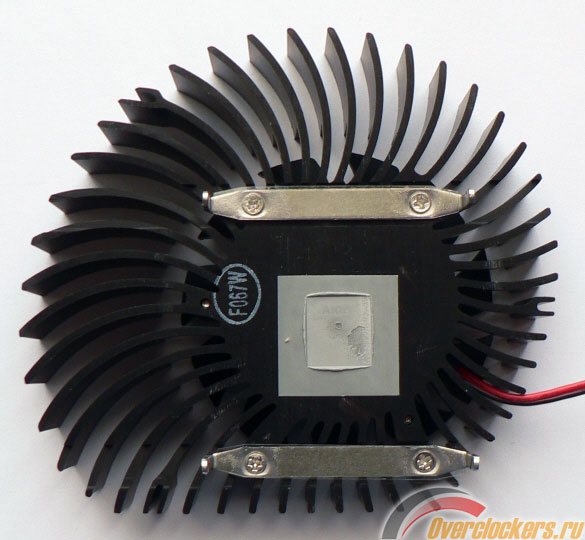
Nevertheless, the temperature regime of the overclocked “by default” video card in the standard assembly turned out to be quite normal:
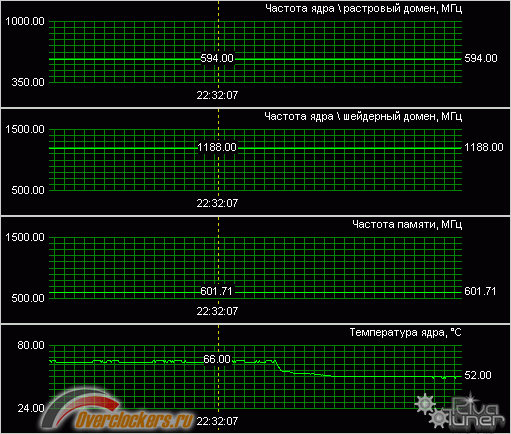
The cooling system is noisy. At a distance of 3 cm from the video card, the measured noise level is 61.8 dBA, and at a distance of 1 meter in a closed case of the system unit – 39.9 dBA. According to subjective feelings, the comfortable noise level is at the mark of ~ 36 dBA.
As a rule, video cards overclocked at the factories have a low overclocking potential, but in the case of the Palit GeForce 8500 GT Sonic 256 MB, everything turned out to be much better. Without replacing the cooling system, the maximum frequencies at which stability was maintained were 729
/
1656
MHz!
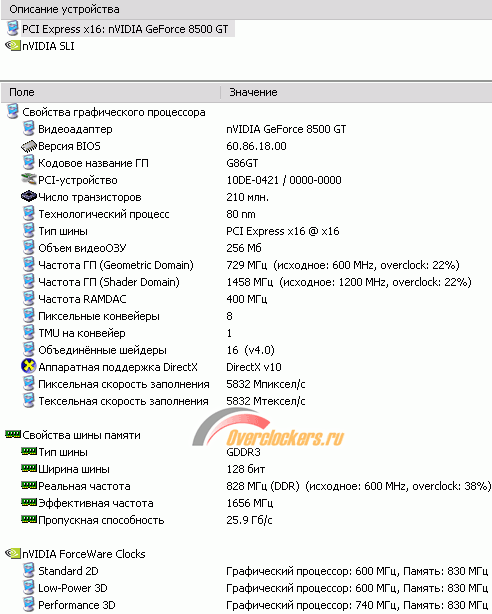
Suffice it to recall that the nominal value of the GeForce 8500 GT is 450/800 MHz, and the frequencies achieved during overclocking turn out to be simply phenomenal: +62% for the graphics processor and more than twice as high for the video card memory! At the same time, the temperature regime increased by only 5 degrees Celsius:
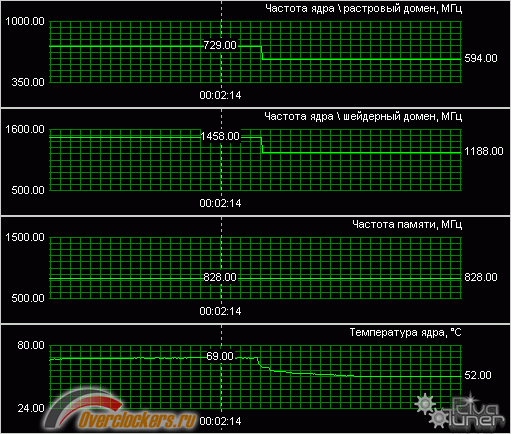
Replacing the standard cooling system with the Arctic Cooling Accelero S2 resulted in a temperature drop of 17 degrees Celsius (52 at peak load), but did nothing to increase the overclocking potential of the card.
Despite the higher frequencies, Palit GeForce 8500 GT Sonic 256 MB costs only $99.
Testing of all video cards was carried out in a closed case of the system unit of the following configuration:
- Motherboard: ASUSTek P5B Deluxe/WiFi-AP (Intel P965), LGA 775, BIOS 1101;
- Chipset cooling system: Thermaltake Extreme Spirit II (~2500 rpm);
- Processor: Intel Core 2 Quad Q6600 2400 MHz, 1.2875 V, L2 2 x 4096 KB, FSB: 266 MHz x 4, (Kentsfield, B3);
- CPU cooling system: CoolJag Falcon 92-Cu (~1400 rpm);
- Thermal interface: Arctic Silver 5;
- RAM: 2 x 1024 MB DDR2 Corsair Dominator TWIN2X2048-9136C5D (SPD: 1142 MHz, 5-5-5-18, 2.1 V);
- Disk subsystem: SATA-II 320 GB, Hitachi (HDT725032VLA360), 7200 rpm, 16 MB, NCQ;
- Case: ATX ASUS ASCOT 6AR2-B Black&Silver (120 mm Cooler Master case fans ~1200 rpm, ~21 dBA are installed on the intake and exhaust, on the side wall there is a 120 mm Sharkoon Luminous Blue LED fan at ~1000 rpm );
- Power supply: MGE Magnum 500 (500 W) + 80 mm GlacialTech SilentBlade fan (~1700 rpm, 19 dBA).
The central processor during testing with an increase in voltage to 1.45 V was overclocked to a frequency of 3200 MHz. At the same time, the RAM operated at a frequency of 1068 MHz with timings of 5-5-5-12 at a voltage of 2.1 V. Do not rush to reproach the test configuration for the video card class that does not match, read the article to the end.
All tests were carried out on Windows XP Professional Edition SP2 (with all the latest updates). Motherboard chipset drivers – Intel Chipset Drivers version 8.4.0.1009a. We used DirectX 9.0c libraries (released April 2007), as well as video card drivers: Catalyst 7.5, ForceWare 93.71 (for GeForce 7300 GT and 7600 GS) and ForceWare 158.19 (for GeForce 8500 GT).
Given the low performance of video cards, testing was carried out at two resolutions 1024 x 768 and 1280 x 1024, but only with graphics quality settings in the “Quality” drivers. That is, all optimizations in the drivers were activated, and Catalyst AI was set to High mode. Anisotropic filtering and FSAA were not activated.
To test the performance of the video card, the following set of synthetic benchmarks and games was used:
- 3DMark 2005 (Direct3D) – build 1.3.0, разрешение 1024 x 768, default settings;
- 3DMark 2006 (Direct3D) – build 1.1.0, разрешение 1280 x 1024, default settings;
- RyderMark (Direct3D) – разрешение 1280 х 1024, shader model 3.0, 32-bit HDR lighting;
- Serious Sam 2 (Direct3D) – game version 2.070, standard demo “GREENDALE”, maximum graphics settings (they were described in more detail earlier);
- FEAR Extraction Point (Direct3D) – game version 1.01, built-in benchmark, all graphics settings during testing set to “Maximum”, Soft Shadows = Off;
- The Elder Scrolls IV: Oblivion (Direct3D) – game version 1.1.511, high quality, bloom effects, distant rendering, “Aleswell – Forest” level, configuration file;
- Prey (OpenGL) – game version 1.2, high quality, “HWzone” demo from HardwareOC Prey Bench (Boost graphics option enabled), double run demo;
- Company of Heroes (Direct3D) – game version 1.3.0, maximum quality, built-in performance benchmark (the settings have already been described in more detail);
- STALKER – Shadow of Chernobyl (Direct3D) – game version 1.001, shader 3.0, Dynamic Lighting and other maximum graphics quality settings were used, a triple run of the demo.
If the tested game does not have a built-in FPS counter and the possibility of fixing its average and minimum values, then the measurement was made using the FRAPS utility. If possible, the minimum FPS indicator was fixed and indicated on the diagrams.
So, we have 4 low-end video cards with the same amount of memory of 256 MB:
- Radeon X1650 Pro (594/1376 MHz, @661/1630 MHz);
- GeForce 7300 GT (350/666 MHz, @486/907 MHz);
- GeForce 7600 GS (400/800 MHz, @540/954 MHz);
- GeForce 8500 GT (450/800 MHz, @729/1656 MHz).
As you can see, the frequencies of Palit’s GeForce 8500 GT have been lowered to the nominal frequencies of NVIDIA GeForce 8500 GT.
Let’s start studying the test results with synthetic benchmarks from Futuremark, which were tested with default settings.
3DMark 2005 & 3DMark 2006
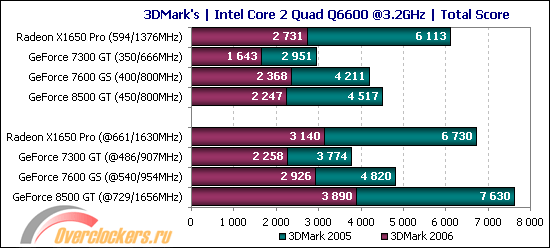
In the nominal mode of operation of video cards, we have a clear leader in two synthetic benchmarks – this is the Radeon X1650 Pro. The GeForce 7600 GS and the new 8500 GT fight almost on equal terms (the former is faster in 3DMark 2006, and the latter in 3DMark 2005). The cheapest video card of today’s tests is the GeForce 7300 GT. With the exception of the leadership of the GeForce 8500 GT, the overall situation does not change during overclocking. But here and below, you should understand that the video card from Palit has an incomparably greater overclocking potential than all the other products tested today, so it would be a mistake to extend its speed to all other video cards of the GeForce 8500 GT class.
RyderMark
A fairly new benchmark RyderMark actively uses shaders of the third version and lighting with a wide dynamic range. The tests were carried out with the following settings:
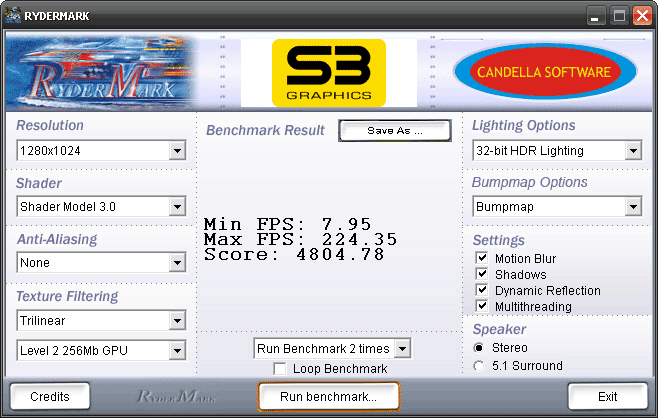
A double run of the benchmark was used. The results are in front of you:
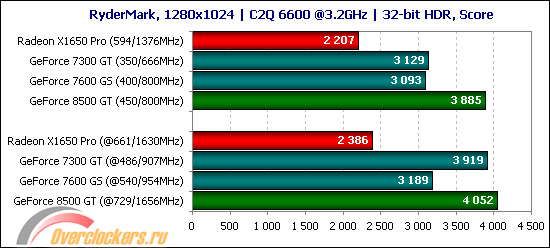
And here the results were already very unexpected. The Radeon X1650 Pro, which was the leader in the previous two synthetic benchmarks, noticeably loses to other video cards in RyderMark. The GeForce 8500 GT has the highest score, while the GeForce 7300 GT manages to outperform the GeForce 7600 GS, which is one step higher. Some illogical results were obtained in this benchmark, but we will not focus on this and move on to the results in real games.
Serious Sam 2

Well, Serious Sam of the second version arranged the video cards in the nominal mode as follows: the fastest is the Radeon X1650 Pro, followed by the GeForce 7600 GS with a slight lag, and then a pair of GeForce 7300 GT and 8500 GT, and these video cards are almost equal in terms of performance among themselves. Moreover, even the impressive overclocking of the video card from Palit does not bring the expected leadership to the GeForce 8500 GT, the new product continues to yield to the Radeon X1650 Pro and GeForce 7600 GS, whose overclocking successes are much more modest. It looks too inexpressive in Serious Sam 2 GeForce 8500 GT.
In general, I note that the average frame rate on both leading video cards remains comfortable even at a resolution of 1280 x 1024, although it should be noted that the Radeon X1650 Pro is far behind the GeForce 7600 GS in terms of the minimum FPS.
FEAR Extraction Point
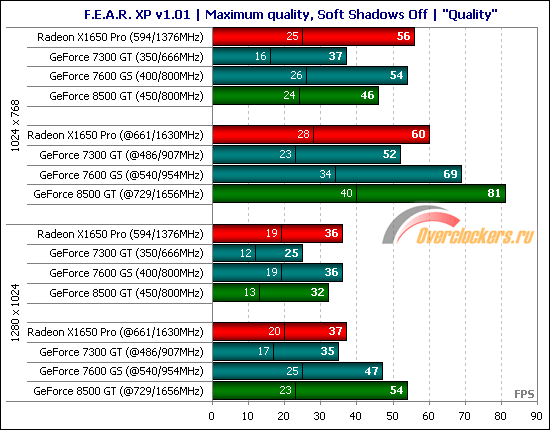
The situation in the FEAR Extraction Point tests is somewhat similar to Serious Sam 2, except for the leading GeForce 8500 GT during overclocking. Only this video card, after overclocking, allows you to feel comfortable in both test resolutions. The Radeon X1650 Pro and GeForce 7600 GS provide an acceptable frame rate only at 1024 x 768, and for the GeForce 7300 GT the FEAR game remains too “heavy” in terms of graphics. You have to lower the quality setting, and this will turn out to be a completely different game …
The Elder Scrolls IV: Oblivion
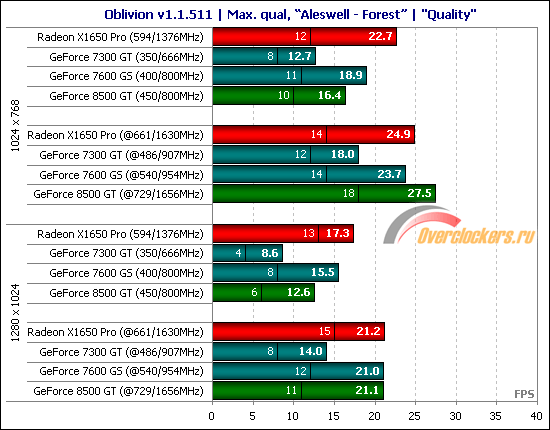
Let me remind you that enabling optimizations in video card drivers and using the “Quality” mode instead of “High Quality” in The Elder Scrolls IV: Oblivion significantly increases the average frame rate. Despite this, video cards are so weak for this game that it is impossible to comfortably run through the vast expanses of Oblivion on any of them. Nevertheless, if we compare video cards at nominal frequencies, then the Radeon X1650 Pro is again in the lead, with the GeForce 7600 GS following a little behind, and only then the GeForce 8500 GT. Closes the four “graphic low-speed” GeForce 7300 GT.
Prey
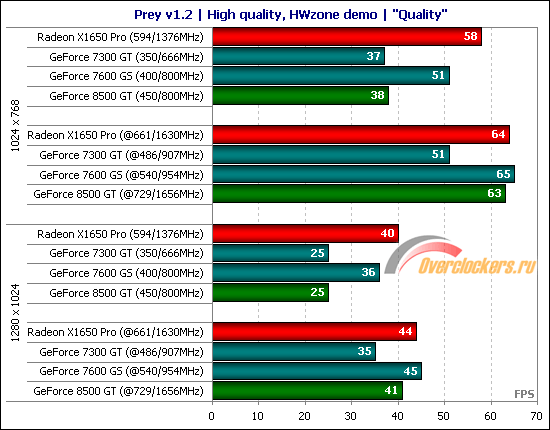
Testing in the Prey game does not bring anything new to the balance of power. I will only note the very inexpressive results of the GeForce 8500 GT, comparable to a single GeForce 7300 GT. Outstanding overclocking of the video card from Palit allows it to reach the level of today’s test leaders: Radeon X1650 Pro and GeForce 7600 GS.
Company of Heroes
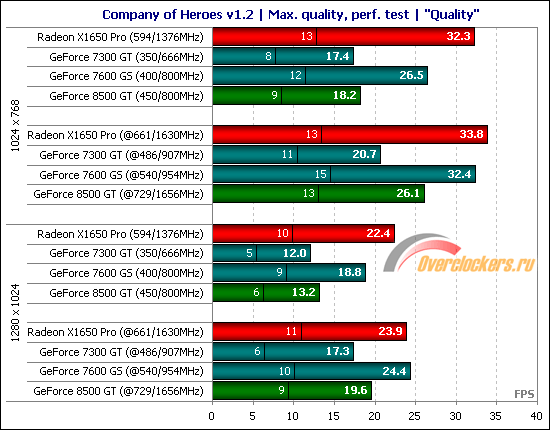
Once again, the GeForce 8500 GT shows depressingly low results. In the nominal mode of operation of video cards, the novelty managed to get ahead of only the GeForce 7300 GT, and the situation does not change during overclocking. A very slow video card, to put it mildly.
STALKER – Shadow of Chernobyl
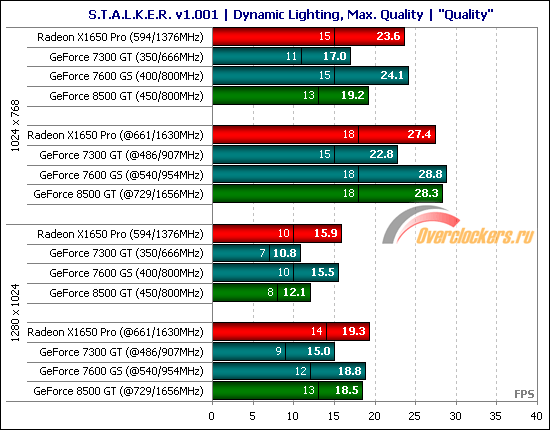
But in the game STALKER – Shadow of Chernobyl, overclocking helps Palit’s GeForce 8500 GT reach the performance level of the less overclocked Radeon X1650 Pro and GeForce 7600 GS. In nominal mode, the results are as deplorable as most of the games tested today.
Now let’s get back to the question of the test system’s inconsistency with the class of tested video cards, which I touched on in the section above. In order to prove that the claims about a too fast system unit for such slow video cards have no basis, I tested the fastest video card of today’s testing on another system. According to the totality of tests, the Radeon X1650 Pro demonstrates the highest performance in the class of video cards up to $100, which is why we decided to test this video card again. Moreover, it was tested not at nominal frequencies, but during overclocking to 661/1630 MHz. In my opinion, it is logical that slower video cards will be even less processor dependent than the one chosen for comparison.
So, the following changes were made to the test configuration specified in the corresponding section:
- Motherboard: DFI LanParty UT NF590 SLI-M2R / G (nForce 590 SLI), Socket AM2, BIOS 29/08/2006;
- Processor: AMD Athlon X2 3800+, 2000 MHz, 1.30 V, L2 2 x 512 KB, Cool&Quiet disable, (Windsor, BH-F2);
- Memory: 1 x 1024 MB DDR2 PC6400 (Digma).
All other components do not affect the performance of the system, or have a minimal impact that will not affect the performance of the system as a whole, so I did not change them. The processor was overclocked to 2600 MHz (quite a mediocre result by today’s standards). The results were quite expected:
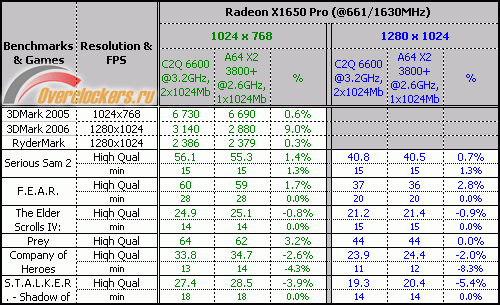
With the exception of 3DMark 2006, all other test results are within the margin of error (+/-1 FPS), which indicates that the tested video cards are not processor-dependent and have minimal dependence on the system speed as a whole. That is, all potential claims regarding the discrepancy between the test bench and the class of video cards in today’s article have no basis.
Based on the results of today’s article, it becomes clear that the GeForce 8500 GT is not able to compete on equal terms with the Radeon X1650 Pro and GeForce 7600 GS. With the exception of the synthetic benchmark RyderMark, the “oldies” turn out to be faster and, at times, quite significantly. Only the extraordinary overclocking of a specific video card from Palit at best allows it to catch up, and in the FEAR game to get ahead of its rivals. But this is just an exception to the rule. As you understand, no one guarantees you the same overclocking as the copy provided to us for testing. In general, we can say that the GeForce 8500 GT has only one advantage over its competitors – support for DirectX 10, but it is only on paper, but in practice it is too illusory for obvious reasons.
It is not difficult to see that in most games video cards of this price range cannot provide comfortable FPS even when overclocked and taking into account the fact that the drivers did not use maximum picture quality modes. After overclocking the Radeon X1650 Pro and GeForce 7600 GS, you can play Serious Sam 2 and one resolution in FEAR (in the same game, as I said above, the GeForce 8500 GT looks good). And that’s it. In order to feel comfortable in all other more modern games, you will either have to reduce the quality modes in the game settings, or even lower the resolution, and then it’s better not to play at all.
Nevertheless, if you still don’t want to pay more than $100 for a video card, then I would advise you to choose from the Radeon X1650 Pro and GeForce 7600 GS, which have approximately the same performance.
Discussions on the topic of the article in the conference Overclockers.ru:
- Всё о RADEON X1600PRO=X1300XT/X1600XT=X1650PRO;
- All about 7300GT/GS/SE/LE + FAQ;
- All about GeForce 7600 (GT/GS). FAQ on the first page;
- All about 8600GT/GTS & 8500GT.
PS We thank the NIX company for providing video cards for testing.
Sergey Lepilov
aka
Jordan
Hardware Capabilities
The graphics accelerator NVIDIA GeForce 8500 GT attracts attention by the fact that, unlike integrated solutions, it supports all existing API libraries, which means that it can work with any software development environment. An additional bonus is full compatibility with DirectX 10, however, after the release of version 12 of this popular library, this feature has lost its relevance.
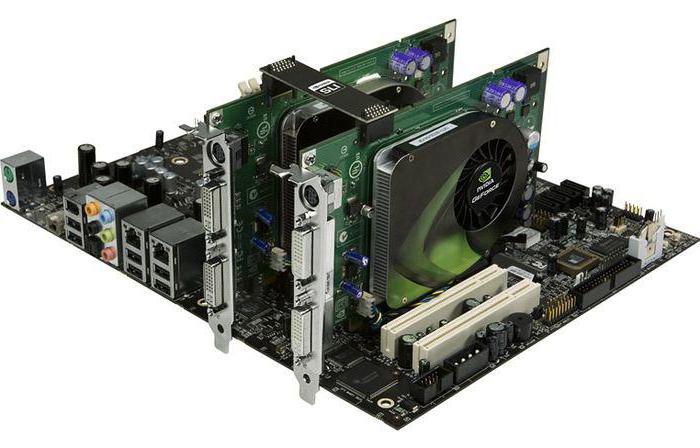
Model 4.0 shaders and 128-bit floating-point dynamic range rendering also look somehow inexpressive in a budget device. Therefore, when buying this video adapter, the user needs to think about choosing a powerful processor for his computer, since the performance of the accelerator cannot be counted on.
Synthetic test packages
The main rivals of this solution are 7600 GT, 8600 GT and Radeon 1600X. All of them had similar parameters and cost and were in the same price range. It is for this reason that it will be most expedient to compare the hero of this article with them. In the synthetic test package 3DMark05, the following results were obtained in relative scores:
- 8600GT – 8653.
- 7600GT – 5827.
- 8500GT – 4456.
- X1600 – 4100.
Older NVidia models, both 7000th and 8000th generations, have an advantage over the hero of this article. The latter without any problems in this test bypasses a direct competitor from AMD.
Oddities in the budget class
It is surprising that such an interesting product has not received recognition from well-known video card manufacturers. Apparently, the lack of potential in games and resource-intensive applications simply cooled the interest of popular brands. On the world market, the NVIDIA GeForce 8500 GT video card is represented by only a dozen manufacturers that offer the end user a silent solution for building a home platform or an office computer.
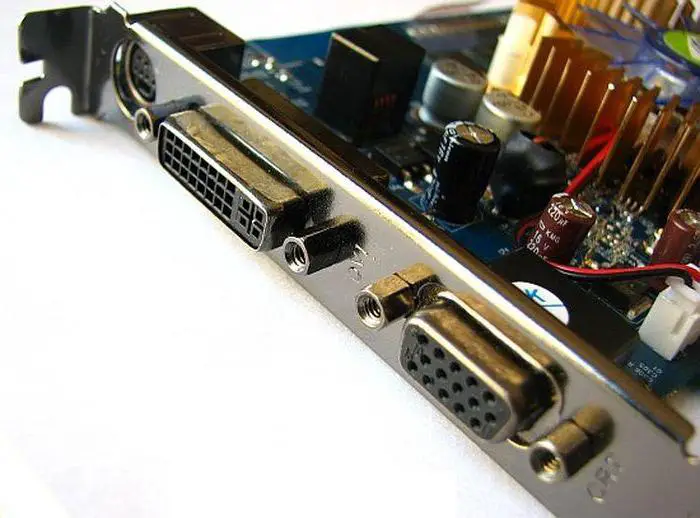
Technologists from Elitegroup, MSI and Biostar corporations decided not to waste time on the product, providing it with the cheapest cooling system and launching it on the market. Taiwanese manufacturers ASUS and Gigabyte showed more respect and made minor improvements to the graphics accelerator. Firstly, a unique copper-based cooling system was created at the factory for the printed circuit board. They also made a small overclocking of the graphics core, which increased the performance of the video adapter.
Reviews. Price
The adapter in question could boast of an ideal balance of performance, speed and cost by the standards of 2007. Now, after 10 years from the start of sales, it is naturally not such, and there is nothing surprising in this. During this time, generations of graphics accelerators have repeatedly changed and the level of performance has increased significantly. As you might guess, in a new form, such an accelerator cannot be purchased. But in a used form on trading floors it can be found. The price for it is 100-300 rubles. Owner reviews indicate that this accelerator is great for implementing office systems. In all other cases, it is better to choose more recent solutions.
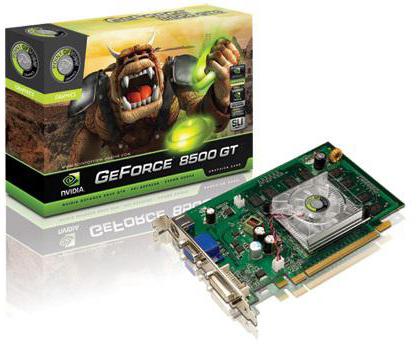
Testing and overclocking the graphics accelerator
The NVIDIA GeForce 8500 GT device has a small heat dissipation package, and therefore provokes many owners to increase the performance of the graphics core by raising the processor frequency. As practice shows, budget representatives, unlike gaming-class video cards, have many problems that can hinder overclocking. The installed memory modules have frequency limits, so it is impossible to raise the frequency above 800 MHz at the hardware level.
The graphics core is more amenable to overclocking – 600 MHz is quite a real frequency for it, only the electrolytic capacitors in the power system get very hot. Accordingly, you need to think about their cooling. Many enthusiasts who have increased the frequency of the GPU recommend ensuring efficient heat dissipation from the system unit, since the efficiency of the video card fan leaves much to be desired.
Feedback from users
The video adapter can be overclocked, and this is an advantage. Moreover, overclocking at best reaches 20% for the NVIDIA GeForce 8500 GT graphics core. Owner reviews note only the need to provide decent cooling to all elements of the printed circuit board. On the other hand, any overclocking contributes to a noticeable improvement in the performance of the video adapter, but in this case the result is almost imperceptible. In the same legendary World of Tanks toy, the user will see an increase in just two frames per second (from 25 to 27 FPS in the minimum video quality settings).
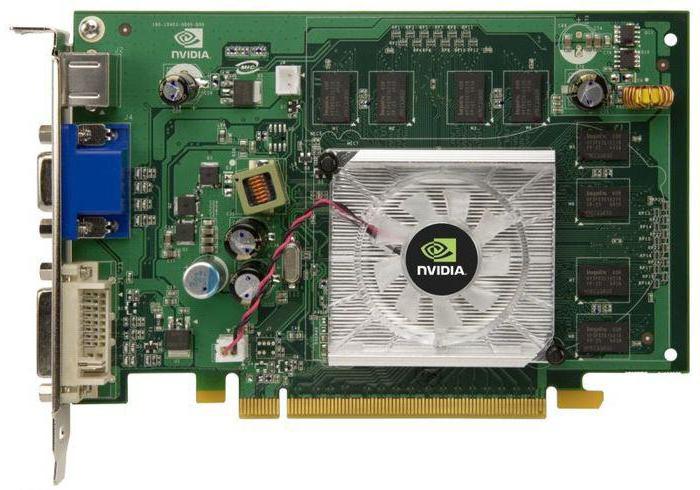
If you omit the gaming capabilities, then you can see a little more advantages. Support for DirectX 10 libraries and APIs allows you to work in a developer environment without problems, and hardware acceleration is quite capable of handling 3D graphics and complex modeling. The absence of requirements for a power supply is undoubtedly a plus for any buyer who can save on buying a computer, because a powerful PSU is very expensive.





